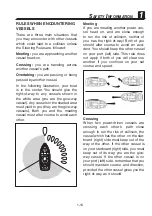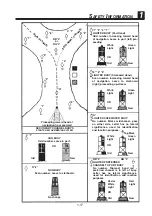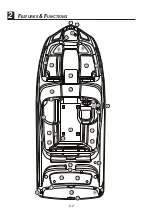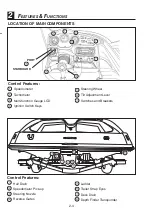
#
S
AFETY
I
NFORMATION
1-14
RULES OF THE ROAD
Your Yamaha Boat is legally considered
a powerboat. Operation of the boat
must be in accordance with the rules
and regulations governing the water-
way on which it is used.
Just as there are rules that apply when
you are driving on streets and high-
ways, there are waterway rules that
apply when you are operating your
boat. These rules are used interna-
tionally, and are also enforced by the
United States Coast Guard and local
agencies. You should be aware of these
rules, and follow them whenever you
encounter another vessel on the water.
Several sets of rules prevail accord-
ing to geographic location, but are all
basically the same as the International
Rules of the Road. The rules presented
here in this Owner’s/Operator’s Manual
are condensed, and have been provid-
ed for your convenience only. Consult
your local U.S. Coast Guard Auxiliary
or Department of Motor Vehicles for
a complete set of rules governing the
waters in which you will be operating
your boat.
STEERING AND SAILING RULES
Whenever two vessels on the water
meet one another, one vessel has the
right-of-way; it is called the “stand-on”
vessel. The vessel that does not have
the right-of-way is called the “give-way”
or “burdened” vessel. These rules deter-
mine which vessel has the right-of-way,
and what each vessel should do.
Stand-On Vessel
The vessel with the right-of-way has the
duty to continue its course and speed,
except to avoid an immediate collision.
When you maintain your direction and
speed, the other vessel will be able to
determine how best to avoid you.
Give-Way Vessel
The vessel which does not have the
right-of-way has the duty to take posi-
tive and timely action to stay out of the
way of the stand-on vessel. Normally,
you should not cross in front of the
vessel with the right-of-way. You should
slow down or change directions briefly
and pass behind the other vessel. You
should always move in such a way that
the operator of the other vessel can see
what you are doing.
The General Prudential Rule regard-
ing the right-of-way is that if a collision
appears unavoidable, neither boat has
the right-of-way. Both boats must avoid
the collision.
In other words, follow the standard
rules except when a collision will occur
unless both vessels try to avoid each
other. If that is the case, both vessels
become give-way vessels.
1
















































